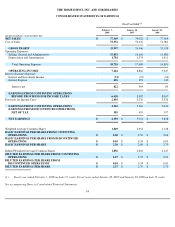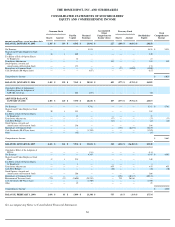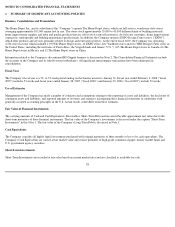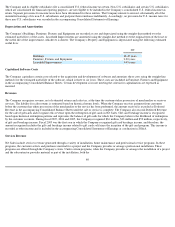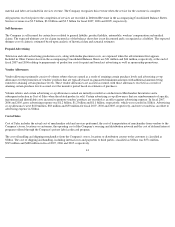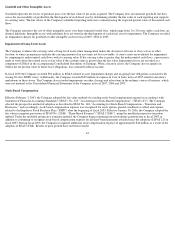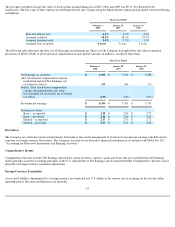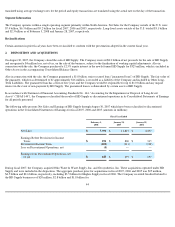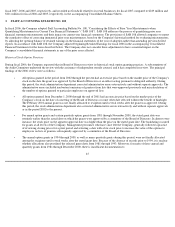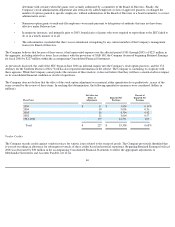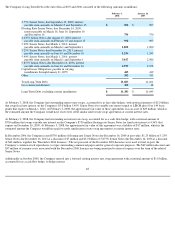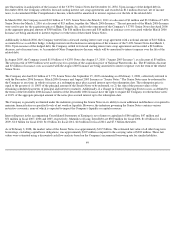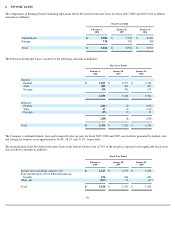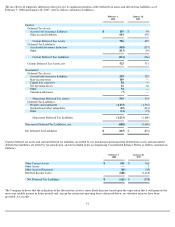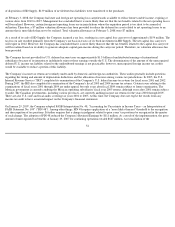Home Depot 2007 Annual Report Download - page 59
Download and view the complete annual report
Please find page 59 of the 2007 Home Depot annual report below. You can navigate through the pages in the report by either clicking on the pages listed below, or by using the keyword search tool below to find specific information within the annual report.
Goodwill and Other Intangible Assets
Goodwill represents the excess of purchase price over the fair value of net assets acquired. The Company does not amortize goodwill, but does
assess the recoverability of goodwill in the third quarter of each fiscal year by determining whether the fair value of each reporting unit supports
its carrying value. The fair values of the Company's identified reporting units were estimated using the expected present value of discounted cash
flows.
The Company amortizes the cost of other intangible assets over their estimated useful lives, which range from 1 to 20 years, unless such lives are
deemed indefinite. Intangible assets with indefinite lives are tested in the third quarter of each fiscal year for impairment. The Company recorded
no impairment charges for goodwill or other intangible assets for fiscal 2007, 2006 or 2005.
Impairment of Long-Lived Assets
The Company evaluates the carrying value of long-lived assets when management makes the decision to relocate or close a store or other
location, or when circumstances indicate the carrying amount of an asset may not be recoverable. A store's assets are evaluated for impairment
by comparing its undiscounted cash flows with its carrying value. If the carrying value is greater than the undiscounted cash flows, a provision is
made to write down the related assets to fair value if the carrying value is greater than the fair value. Impairment losses are recorded as a
component of SG&A in the accompanying Consolidated Statements of Earnings. When a location closes, the Company also recognizes in
SG&A the net present value of future lease obligations, less estimated sublease income.
In fiscal 2005 the Company recorded $91 million in SG&A related to asset impairment charges and on-going lease obligations associated with
closing 20 of its EXPO stores. Additionally, the Company recorded $29 million of expense in Cost of Sales in fiscal 2005 related to inventory
markdowns in these stores. The Company also recorded impairments on other closings and relocations in the ordinary course of business, which
were not material to the Consolidated Financial Statements of the Company in fiscal 2007, 2006 and 2005.
Stock-Based Compensation
Effective February 3, 2003, the Company adopted the fair value method of recording stock-based compensation expense in accordance with
Statement of Financial Accounting Standards ("SFAS") No. 123, "Accounting for Stock-Based Compensation" ("SFAS 123"). The Company
selected the prospective method of adoption as described in SFAS No. 148, "Accounting for Stock-Based Compensation – Transition and
Disclosure," and accordingly, stock-based compensation expense was recognized for stock options granted, modified or settled and expense
related to the Employee Stock Purchase Plan ("ESPP") after the beginning of fiscal 2003. Effective January 30, 2006, the Company adopted the
fair value recognition provisions of SFAS No. 123(R), "Share-Based Payment" ("SFAS 123(R)"), using the modified prospective transition
method. Under the modified prospective transition method, the Company began expensing unvested options granted prior to fiscal 2003 in
addition to continuing to recognize stock-based compensation expense for all share-based payments awarded since the adoption of SFAS 123 in
fiscal 2003. During fiscal 2006, the Company recognized additional stock compensation expense of approximately $40 million as a result of the
adoption of SFAS 123(R). Results of prior periods have not been restated.
42


